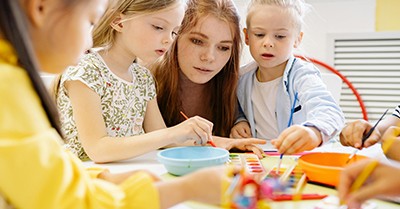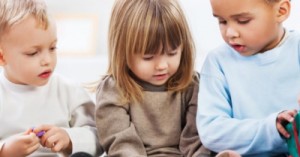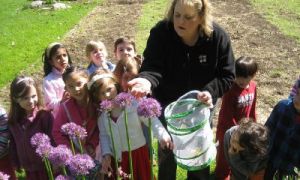Effective pedagogical strategies in early childhood education are grounded in developmental theory, child agency, and emotionally intelligent practice. Here’s an overview of the most impactful approaches currently shaping high-quality early learning. The following article provides information on: Core Pedagogical Strategies with Examples, Supporting Diverse Learners with Examples, Family Engagement as Pedagogy with Examples and more.
Core Pedagogical Strategies
-
Play-Based Learning
Encourages exploration, creativity, and problem-solving. Children learn best through hands-on experiences that mirror real-world scenarios. -
Inquiry & Project-Based Learning
Frames children as “tiny detectives,” investigating topics through questions, experiments, and collaborative projects. -
Reggio Emilia-Inspired Ateliers
Uses art as a second language, valuing children’s expression and co-construction of knowledge in beautifully curated spaces. -
Montessori Practical Life Stations
Builds independence and fine motor skills through purposeful tasks like pouring, sweeping, and food prep. -
HighScope Plan-Do-Review Cycles
Empowers children to set intentions, act on them, and reflect—boosting executive function and self-regulation. -
Trauma-Informed & Healing-Centered Practices
Prioritize emotional safety, predictable routines, and responsive relationships to support children’s resilience. -
Multilingual & Dual-Language Immersion
Enhances cognitive flexibility and cultural awareness, especially when integrated through songs, stories, and daily routines. -
Socio-Cultural & Constructivist Foundations
Draws from Vygotsky and Piaget to center learning in social interaction and meaning-making. Children build knowledge by connecting new ideas to lived experience.
Core Pedagogical Strategies with Examples
Play-Based Learning
- Example: A toddler room sets up a “mini market” with baskets, pretend money, and diverse food items. Children role-play shopping, practicing turn-taking, counting, and cultural food recognition.
Inquiry & Project-Based Learning
- Example: Preschoolers notice ants in the garden. Educators co-design an “Ant Investigation” project with magnifying glasses, ant tunnels, books, and child-led questions like “Where do ants sleep?”
Reggio Emilia-Inspired Ateliers
- Example: Children explore “feelings through color” using watercolors, mirrors, and emotion cards. Their artwork is displayed with captions like “This is my stormy heart when I miss Mum.”
Montessori Practical Life Stations
- Example: A 3-year-old carefully pours water from a small jug into cups, then wipes spills with a cloth. The station includes child-sized tools and visual cues for independence.
HighScope Plan-Do-Review Cycles
- Example: Children choose to build a city with blocks. After play, they gather to reflect: “I made a hospital because my grandma was sick.” Educators document this for family sharing.
Trauma-Informed & Healing-Centered Practices
- Example: A quiet “cozy corner” with soft textures, emotion dolls, and breathing prompts helps children self-regulate. Educators model calm language: “You’re safe here. Let’s breathe together.”
Multilingual & Dual-Language Immersion
- Example: During morning circle, educators greet children in Tamil, Hindi, and English, then sing a welcome song in all three languages. Visual aids support understanding.
Socio-Cultural & Constructivist Foundations
- Example: Children bring photos of their homes. Educators create a “My World Wall” where children share stories, compare homes, and build cardboard models together.
Supporting Diverse Learners
-
Differentiated Instruction
Tailors learning experiences to children’s developmental levels, interests, and cultural backgrounds. -
Observation & Documentation
Uses learning stories, portfolios, and anecdotal records to track progress and inform planning. -
Culturally Responsive Teaching
Embeds children’s home languages, traditions, and identities into the curriculum to foster belonging.
Supporting Diverse Learners with Examples
Differentiated Instruction
- Example: During story time, some children use puppets to retell the tale, others draw scenes, and one child uses a switch-adapted device to share their favorite part.
Observation & Documentation
- Example: An educator notices a child repeatedly stacking cups. They document this as “early engineering interest” and plan a STEM provocation with ramps and pulleys.
Culturally Responsive Teaching
- Example: A child’s family celebrates Onam. Educators invite the family to share traditions, create a flower rangoli with children, and read stories featuring Kerala landscapes.
Family Engagement as Pedagogy
-
Co-Teaching with Families
Strategies like “Ask Me About…” photo texts or home learning kits turn families into active partners. -
Community-Linked Learning
Excursions, guest visitors, and local storytelling connect children’s learning to their broader world.
Family Engagement as Pedagogy with Examples
Co-Teaching with Families
These strategies invite families to actively shape learning experiences, share expertise, and extend children’s thinking beyond the service walls.
“Ask Me About…” Cards
- Example: Educators send home photo cards showing a child painting. Families respond with voice notes: “She said it’s a rainbow for her baby brother!”
- Pedagogical Value: Builds continuity between home and centre, amplifies child voice, and validates emotional connections.
Family Skill Shares
- Example: A grandparent visits to teach weaving. Children create mini looms, and families send photos of home weaving projects.
- Pedagogical Value: Honors intergenerational knowledge and cultural practices.
Home Story Extensions
- Example: After reading The Very Hungry Caterpillar, educators ask families to share what their child eats at home. Families send photos or recipes, which are added to a class book.
- Pedagogical Value: Embeds literacy in lived experience and affirms diverse food cultures.
Community-Linked Learning
These examples connect children’s learning to local places, people, and shared histories—making pedagogy visible and relevant.
Bakery Visit & Role Play
- Example: Children visit a local bakery. Back in the centre, they role-play baking, write recipes, and create a “Bakery Book” with photos and child captions.
- Pedagogical Value: Links real-world experiences to literacy, numeracy, and dramatic play.
Market Mapping
- Example: Children walk to the local market and sketch maps of their route. Families add notes: “This is where we buy mangoes every Saturday!”
- Pedagogical Value: Builds spatial awareness and embeds family routines into curriculum.
Public Art Collaboration
- Example: Children visit a mural in the community. Families are invited to contribute symbols or stories from their culture to inspire a collaborative artwork.
- Pedagogical Value: Fosters cultural inclusion and civic pride.
Home-Centre Learning Loops
These examples create reciprocal learning pathways between home and service, with families contributing insights, materials, and reflections.
“What’s Special at Home?” Boxes
- Example: Families send in a small item that represents something special at home (e.g., a cooking spoon, prayer bead, photo). Children share stories, and educators document the narratives.
- Pedagogical Value: Builds identity, emotional safety, and storytelling skills.
Family Soundscapes
- Example: Families record sounds from home—singing, cooking, birds—and children use them to create sound collages or rhythm games.
- Pedagogical Value: Encourages sensory exploration and celebrates diverse auditory environments.
Loose Parts from Home
- Example: Families contribute safe, meaningful loose parts (e.g., sari scraps, bottle caps, shells). Children use them in collage, construction, and storytelling.
- Pedagogical Value: Extends play possibilities and embeds family presence in daily learning.
Further Reading
Embedding Possum Skin Pedagogy In Early Childhood Programs
Pedagogical Approaches In Early Childhood
8 Aboriginal Ways of Learning
Infant And Toddler Pedagogy
What Is Pedagogy In Early Childhood
Pedagogical Documentation







 Here is the list of the EYLF Learning Outcomes that you can use as a guide or reference for your documentation and planning. The EYLF
Here is the list of the EYLF Learning Outcomes that you can use as a guide or reference for your documentation and planning. The EYLF The EYLF is a guide which consists of Principles, Practices and 5 main Learning Outcomes along with each of their sub outcomes, based on identity,
The EYLF is a guide which consists of Principles, Practices and 5 main Learning Outcomes along with each of their sub outcomes, based on identity, This is a guide on How to Write a Learning Story. It provides information on What Is A Learning Story, Writing A Learning Story, Sample
This is a guide on How to Write a Learning Story. It provides information on What Is A Learning Story, Writing A Learning Story, Sample One of the most important types of documentation methods that educators needs to be familiar with are “observations”. Observations are crucial for all early childhood
One of the most important types of documentation methods that educators needs to be familiar with are “observations”. Observations are crucial for all early childhood To support children achieve learning outcomes from the EYLF Framework, the following list gives educators examples of how to promote children's learning in each individual
To support children achieve learning outcomes from the EYLF Framework, the following list gives educators examples of how to promote children's learning in each individual Reflective practice is learning from everyday situations and issues and concerns that arise which form part of our daily routine while working in an early
Reflective practice is learning from everyday situations and issues and concerns that arise which form part of our daily routine while working in an early Within Australia, Programming and Planning is reflected and supported by the Early Years Learning Framework. Educators within early childhood settings, use the EYLF to guide
Within Australia, Programming and Planning is reflected and supported by the Early Years Learning Framework. Educators within early childhood settings, use the EYLF to guide When observing children, it's important that we use a range of different observation methods from running records, learning stories to photographs and work samples. Using
When observing children, it's important that we use a range of different observation methods from running records, learning stories to photographs and work samples. Using This is a guide for educators on what to observe under each sub learning outcome from the EYLF Framework, when a child is engaged in
This is a guide for educators on what to observe under each sub learning outcome from the EYLF Framework, when a child is engaged in The Early Years Learning Framework describes the curriculum as “all the interactions, experiences, activities, routines and events, planned and unplanned, that occur in an environment
The Early Years Learning Framework describes the curriculum as “all the interactions, experiences, activities, routines and events, planned and unplanned, that occur in an environment


